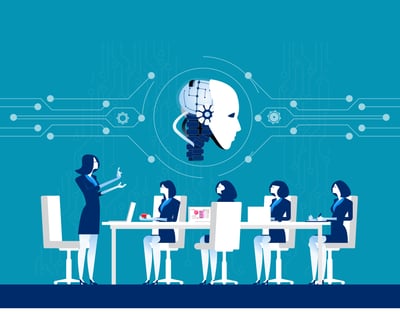October 14, 2025
 by Sidharth Yadav / October 14, 2025
by Sidharth Yadav / October 14, 2025

A few weeks ago, I found myself in two different conversations about AI.
In one, a customer relationship management (CRM) company's chief information officer (CIO) told me about rolling out an AI copilot among its 5,000 employees. “We’re investing seven figures in this,” he said casually.
The same week, I chatted with the founder of a five-person startup. She had been experimenting with ChatGPT for inventory planning, but she paused when I mentioned the copilot’s enterprise licensing fees. “That’s more than my payroll for three months,” she said, chuckling.
That’s the AI divide in one snapshot.
On one hand, larger companies are pouring billions into AI innovation and infrastructure. On the other hand, small businesses, which make up the majority of all U.S. companies and employ nearly half the workforce, are asking whether they can justify $30 a month for a single AI seat.
The divide is not just about size. It’s about capacity, flexibility, and the way technology is delivered. As Tim Sanders, Chief Innovation Officer at G2, shared in the company’s 2025 Buyer Behavior Report: “AI is no longer hype. It’s now infused into workflows and business strategies. AI now stands for Always Included.”
The expectation has shifted: whether you are a Fortune 100 or a retailer, AI is no longer optional.
The question is whether small businesses can keep up or will AI widen a gap that already disadvantages them. It may be more nuanced. Yes, AI risks creating a divide. But small businesses could also punch above their weight if they play on their strengths using AI.
Let’s explore this in detail.
Financial and capacity gaps are significant: Large enterprises invest millions in custom AI, while SMBs struggle with costs as low as $30/month. This is due to a lack of capacity, not a lack of willingness.
The market is shifting from "build" to "buy": While large firms once gained an edge from custom-built AI, the market now favors plug-and-play tools that offer higher speed to value and proven performance. This trend benefits agile small businesses.
AI democratizes key functions: AI acts as an equalizer, enabling small businesses to deliver enterprise-level customer service and marketing without the overhead. AI chatbots provide 24/7 support, and content tools democratize marketing for small teams.
How small businesses can catch up:
Start small but start now: Begin with one specific use case. It could be customer service chatbots, social media content creation, or basic data analysis. Master that before expanding.
Form learning partnerships with other SMBs: Create informal AI user groups in your industry or region. Share experiences, split the cost of training, and collectively negotiate better rates with AI vendors.
Invest in AI literacy before AI tools: Send team members to online AI courses, attend webinars, or partner with local business schools. Understanding AI's capabilities and limitations is more valuable than having the latest software without knowing how to use it effectively.
The AI revolution is experienced differently depending on a company's size, resources, and geographic location. The AI divide is multifaceted, and to understand its implications, we must map its various fault lines. Here are the key divisions that define the current market:
Enterprises buy and deploy differently from smaller businesses. They can commit large budgets to pilots, staff cross-functional teams, and accept multi-quarter payback horizons. Bloomberg’s market reporting on 2025 capital trends shows the math: Microsoft’s multi-billion-dollar AI capex plans place it in a different investment universe from nearly every small business.
“Enterprises have the luxury of bigger budgets and larger teams to pilot, iterate, and absorb the risk of AI adoption. For smaller companies, the barriers are less about willingness and more about capacity.”
Chris Donato
Chief Revenue Officer, Zendesk
Not all small businesses are the same. Some are digitally savvy, many are not. The Bipartisan Policy Center’s polling of small businesses suggested that while interest is high, awareness, affordability, and skills were constraints for many.
Marketing strategist Ivy Brooks explains this split: Larger companies hire specialists, while a small-business owner can use AI to “take things off their plate…giving roles to AI they hadn’t yet given to hired help.” That description captures the pragmatic side of adoption.
And then there’s pricing. Monica Kruger, a remote agent assistant, voiced the frustration I’ve heard from many small business leaders: “I don’t think it’s fair to charge the same price as a company that can easily pay the subscription versus a company that’s struggling to meet their overheads with fewer clients.”
So the “within SMB” divide is about pragmatism versus paralysis. Some small businesses are thriving with AI, while others are locked out by cost, complexity, or confidence.
The World Economic Forum explains that AI's benefits are concentrated in the Global North, while the Global South risks being left behind. The reasons mirror what we see at the business level: compute infrastructure, capital, and skilled labor are unevenly distributed.
The LSE Business Review frames the problem as first and foremost a digital-infrastructure and policy challenge. Unreliable connectivity, limited AI-ready datasets, low local practitioner capacity, and the concentration of capabilities among a few large players mean that many countries will remain downstream consumers unless governments invest in public research, procurement, and upskilling.
The factors creating this divide are a combination of financial barriers, technological needs, and organizational differences. Beyond capital, there are disparities in data access, the affordability of advanced AI tools, and the technical skills within the workforce. This means the technology designed to boost productivity for all is, ironically, threatening to solidify the advantages of the dominant market players.
While AI promises to boost productivity and innovation for all, it’s also exacerbating existing inequalities and creating new ones. Large companies are racing ahead, while many small businesses are struggling to keep up. The factors include a mix of financial, technological, and organizational challenges.
Enterprises with deep pockets can invest in custom chips, data centers, and contracts with model providers. The Bloomberg article (as mentioned above) reports that megacaps are racing ahead with infrastructure while small-cap tech firms struggle to keep up.
For many use cases, such as personalization, cybersecurity, and large-scale data ingestion, you need high-performance infrastructure. SMBs can’t afford all of it. They need affordable, predictable inference. But the market is drifting into a two-tier structure. One is a premium low-latency service for enterprises. The other includes slower tiers for everyone else.
Enterprises have years of customer data. This includes CRM records, call transcripts, and purchase histories. That gives them an advantage in fine-tuning and personalization. Small firms, by contrast, often live in spreadsheets and email threads. They simply don’t generate enough high-quality labeled data to build robust models.
That difference shows up in sales. Pipedrive found that SMB adoption of AI in sales jumped from 35% to 80% within a year. But most of that adoption is in off-the-shelf assistants, not customized models. Enterprises, meanwhile, are embedding predictive scoring and hyper-personalization into their workflows.
“Around 80% of sales professionals are either using AI or plan to adopt it soon, a significant leap from early 2024 when only 35% had embraced AI-powered tools.”
Pipedrive report
The result is not that SMBs avoid AI. It’s that their AI remains generic, while enterprises train theirs to know customers better.
The advanced AI models and tools are expensive for all but the largest businesses.
For instance, Microsoft 365 Copilot requires a minimum of 300 users at $30 per user per month, costing at least $108,000 annually. Similarly, a custom, internal-only GPT from OpenAI can cost millions, starting at $2 to $3 million for consideration.
This creates a digital divide, as these advanced tools are well within reach for large organizations but relatively inaccessible to SMBs.
While large companies are hiring for new, specialized roles, like AI data scientists and machine learning engineers, smaller businesses face a more fundamental challenge: a lack of general AI knowledge among their workforce.
A study on UK small businesses found that a primary reason for reluctance to adopt AI is perceived complexity and a lack of technical expertise. Only 33% of SMB AI users surveyed by Microsoft received proper training, and the majority of small business leaders simply "don't know enough about AI." This creates a skills gap where employees feel unprepared and struggle to use new tools to their fullest potential.
The story of the Great AI Divide isn't just about large companies racing ahead. Small businesses don't have to win by outspending enterprises; they can win through innovation. By using their agility and the development of accessible, plug-and-play AI tools, small businesses have the opportunity to use AI as an equalizer.
Many small companies are finding that their size and agility are their unique assets in the AI race. It’s not about competing with enterprises to outpace them, but to use AI in a way that plays on an SMB’s strengths. This section explores how AI can act as an equalizer, democratizing access to tools and capabilities.
AI is closing the gap between small businesses and large enterprises by democratizing powerful tools. For instance, AI-driven chatbots and virtual assistants can provide 24/7 customer support, a capability once reserved for companies with massive call centers.
Chris notes that AI is "collapsing the gap between the resources of a Fortune 500 and a 50-person business" by instantly providing capabilities such as intent detection, automated routing, and real-time suggested responses.
He points to the recently announced AI innovations at the Zendesk AI Summit that could bridge the service delivery gaps between small and large companies.
"The new Resolution Platform brings capabilities like voice AI agents that can autonomously resolve complex issues, and copilot tools that guide agents in real time with summaries, insights, and next-best actions," he explains.
Zendesk has also introduced AI-driven workflow builders that detect friction and automate fixes in real time. "You don't need a coding or data team for this," he says. Such capabilities give small businesses enterprise-grade power.
In marketing, AI makes it possible for a small business to create professional-quality content, ads, and social media posts that previously required expensive agencies or in-house teams.
"Small businesses can now create professional-quality content, ads, and social media posts that used to require expensive agencies or in-house marketing teams," says Sumarie Nel, a content creator and part of the G2 Icon community. Icons are experienced professionals passionate about providing software feedback.
The key to winning isn't to match the spending of large corporations, but to invest strategically.
Leandro Perez, Chief Marketing Officer of Australia and New Zealand at Salesforce, argues that SMBs have a unique advantage because they aren't "encumbered by legacy systems, data hygiene, and data accessibility that can inhibit larger organizations moving fast."
This allows small businesses to adopt an "agent-first" strategy, building seamless customer experiences that foster loyalty and accelerate growth.
As Senior Marketing Manager at Trystar Rahul Agarwal explains, “Large companies often face ‘a lot of red tape around how AI gets used’ due to the need for standardization, making them less agile than smaller, more experimental firms.”
The traditional competitive dynamic, where enterprises gained a moat by building custom AI, is losing steam. The market has shifted, and buyers, regardless of size, now prioritize "speed to value and proven AI performance", according to Chris.
Leandro contrasts the risk of enterprises building their own solutions with the reliability of "plug-and-play" tools that SMBs use. This trend favors SMBs, who can rapidly deploy pre-built AI solutions without the risk of their own DIY projects, which often struggle with accuracy and many times fail to move beyond the pilot phase.
For rapid deployment, AI software sellers must offer special customer service to smaller companies to help them understand different use cases and the potency of AI tools to match up to larger companies, believes Konjengbam Mitindra Singh, a Business Development Representative.
The AI divide is real, but it's not insurmountable. While enterprises continue to invest heavily in custom AI infrastructure, the next three years will be critical for small businesses to establish their footing. The gap may widen initially, but market forces are working to democratize AI access through better pricing models and simpler tools.
There is likely to be a level playing field. We may see more AI providers introduce tiered pricing specifically for SMBs, similar to how cloud computing evolved from enterprise-only to accessible for businesses of all sizes.
The divide exists, but history shows that transformative technologies eventually become accessible to businesses of every size. Small businesses that embrace this transition thoughtfully, by focusing on practical applications rather than trying to match enterprise budgets, will not just survive the AI revolution, they'll thrive in it.
The linear sales funnel marketers have spent decades mastering is subverted. Buyers are looking for proof, not pitches. Learn how UGC is reshaping B2B Buyer Behavior.
Sidharth Yadav is a senior editorial content specialist at G2, where he covers marketing technology and interviews industry leaders. Drawing from his experience as a journalist reporting on conflicts and the environment, he attempts to simplify complex topics and tell compelling stories. Outside work, he enjoys reading literature, particularly Russian fiction, and is passionate about fitness and long-distance running. He also likes to doodle and write about employee experience.
2024 was the year of tech giants touting the enterprise-readiness of AI software.
 by Sidharth Yadav
by Sidharth Yadav
You know what they say is the best part of entrepreneurship? You get to choose the 80 hours...
 by Dan Roberge
by Dan Roberge
Enterprise businesses (you know, multi-million dollar companies that don’t need any more name...
 by Rebecca Reynoso
by Rebecca Reynoso
2024 was the year of tech giants touting the enterprise-readiness of AI software.
 by Sidharth Yadav
by Sidharth Yadav
You know what they say is the best part of entrepreneurship? You get to choose the 80 hours...
 by Dan Roberge
by Dan Roberge


